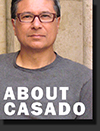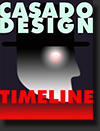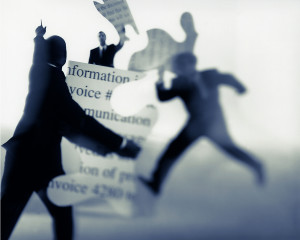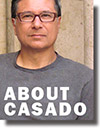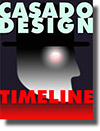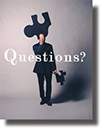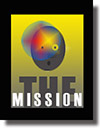Ask your brain a question and let it go to work!
There are lots of gifted people who come up with good ideas time after time. And there are people who struggle. Those that are gifted have no fears. They are aware that they can learn something positive from their wrong answers. For those that doubt the strength of their creativity, the road is longer- but still hopeful. The trick for the ‘less brave’ is to mentally accumulate the right “stuff” and stockpile a cache of ideas and practices. I consider it magic how all this stuff comes together to create an idea. However, it takes practice, and with enough repetition you will develop confidence, and ultimately be successful. It is my contention that the majority of the people who succeed, do so because they have a passion and a large dose of tenacity.
I have been practicing the art of setting my creativity on fire for many years. Though my competitive spirit and confidence were of significant help, I discovered that having a process was a clearer path to better ideas and also served as a sort of benchmark as I moved forward.
In this blog, I am going to reveal my process and many different thoughts about it. I am here to give you inspiration and ideas about how to turn up the fire of your creativity.
Who’s going to benefit from all this?
Everyone is capable of having good ideas, yet each person’s entry level is different, The need to be creative is not limited to designers, artists, or entrepreneurs. Everyone needs the confidence to step up and express themselves. Companies usually use teams to find creative ideas and that’s fine, but for me, it all starts with the individual.
Most of the young people I have mentored have chosen careers that required them to come up with new ideas, often on the spot, like during a job interview or a brainstorming session. They were able to use the skills I taught them in all sorts of diverse situations. It was at their urging that I decided to write this blog.
What do you have to do to be more creative?
Develop your confidence and share an enthusiasm for your answers. Be open to inspiration. Understanding what the creative process is all about.
My version of creative thinking will appear to be very simple at first, but it’s very complex, and riddled with contradictions. Some of my best ideas were right at my feet and I didn’t see them. I promise you, that if you understand and develop your own creative process, the path will become fun, you will find it easier to be more focused and you will make you feel more confident. You will learn to love working on an assignment, finding the answers, presenting it with enthusiasm and seeing it working out in the world. In the end, there is no greater feeling.
This is what will happen.
I am going to tell you about my own experiences with creativity. I going to try and do this weekly to start – keep your fingers crossed. This is a big subject and not linear. I may jump around in order to deal with the contradictions, but in the end, I hope all the parts will make up the whole. I am not a professional writer, so please bear with me as I may struggle to get my ideas across. And please, let me know if I am not being clear.
I hope you will find this a place to have conversations and be inspired.
John Casado
The Brain
Let’s start with the obvious. I know you would like me to go straight to the big answers, but I first want you to feel comfortable with the notion that there is a definite place to go to find your own answers.
It works like this…You have to ask your brain a question –then get out of the way and let it go to work.
Obviously, it’s the brain that you rely on for your thought process and imagination. It can give you an analytical approach and it can come up with some crazy ideas. We have the controls to use either or both to solve a problem. I just want to share this over simplification of the brain to assure you that what you need to be more creative is sitting right between your ears.
I recall watching Charlie Rose and his program on the brain. I was totally fascinated by all the discussions about how it worked. It became clear for me that the artistic or problem solving part of the brain was just one of many, like The Perceiving Brain, The Acting Brain, The Social and Developing Brain as well as the Aging Brain and The Emotional Brain. All of the neuroscientists on the show managed to break it all down so we could understand the vastness of the subject.
Here are the parts of our brain we need to know about.
We have parts of our brain that are the conscious, subconscious and unconscious for our use. The conscience part is the tip of the iceberg according to Freud. It’s all about the here and now- our immediate state of mind; how we process all that we talk, think about in the moment, and have quick access to it.
Next we have a preconscious or subconscious. This is the filter to the rest of your brain. If you asked your brain- what did you do last night?, the answer would come through your preconscious. This is where we collect our knowledge and where our prior experiences live. It contains, for the most part, everything we don’t suppress.
And finally we have the unconscious that contains our repressed feelings and automatic
Thoughts and actions- things we call unintentional behavior. The study of this subject is now called Cognitive Psychology. For our purposes and so it doesn’t get too clinical, it’s the conscious and subconscious that we can use for developing our creativity.
So here’s the takeaway…
All your ideas are there in your brain, we just have to find a way to get them out. And we also need to learn how to feed our brain with stuff to improve our ability to be creative.
My Own Experience.
I am the kind of person that needs to be isolated in order to access my creativity. I need a quiet place so my brain can hear my questions clearly. But I couldn’t always find a quiet place, so one day I decided I would listen to my favorite Rolling Stones album and I realized that in spite of the loud music I felt mentally alone. I decided to try and work with this loud music. It was energizing, to say the least, and I really came in contact with my thought process. It was as though my brain was yelling back at me. I used this technique all during the 70’s when I was doing album covers.
Here are examples of questions that I will write about in the future:
How do we develop our creative Imagination?
How do we access those ideas?
How do we pose our questions to get creative answers?
How do we improve our brain to be more creative?
How do we know if our brain has given us the right answer?
How do we edit what our senses tell us?
How do we keep up with the times?
What does having the “Right Frame of Mind” have to do with being creative?
How do we improve our “Right Frame of Mind”?
What are some exercises that will open our eyes?
Is there a workflow or process to find a creative solution?
When do we ask the question that’s looking for an idea?
What are the signals that our brain is giving us an idea that works?
Is creativity fact or fiction?
What do I do if I can’t figure this out or my brain doesn’t come up with anything?
“Problems cannot be solved by the same level of thinking that created them.”- Albert Einstein.
